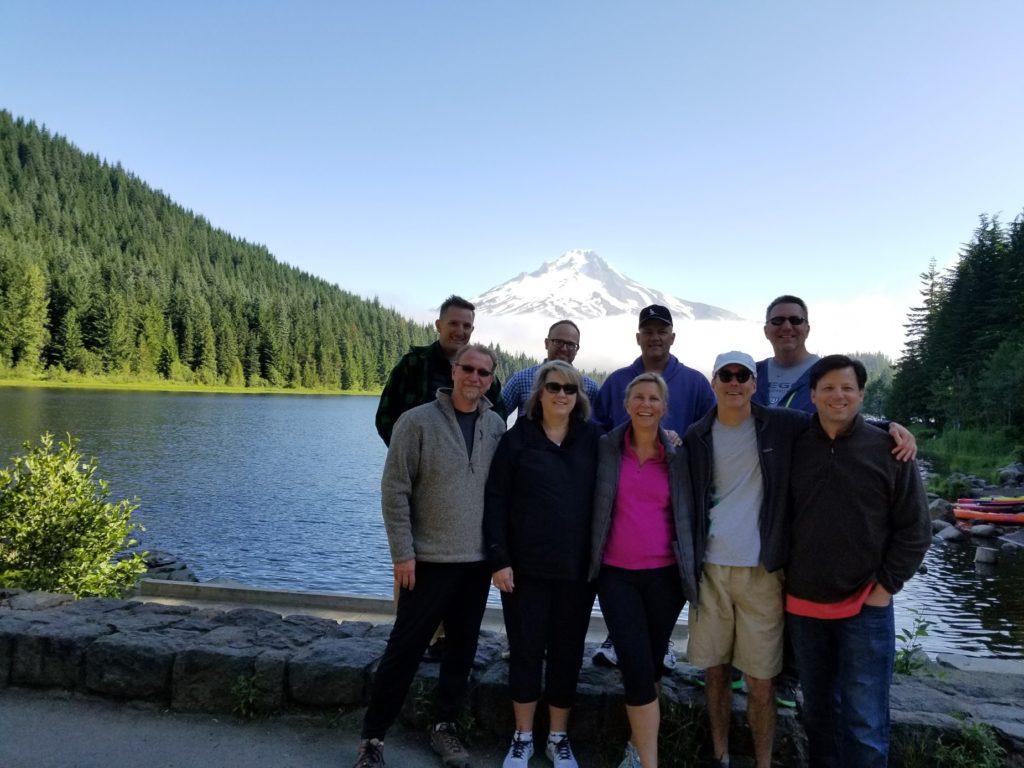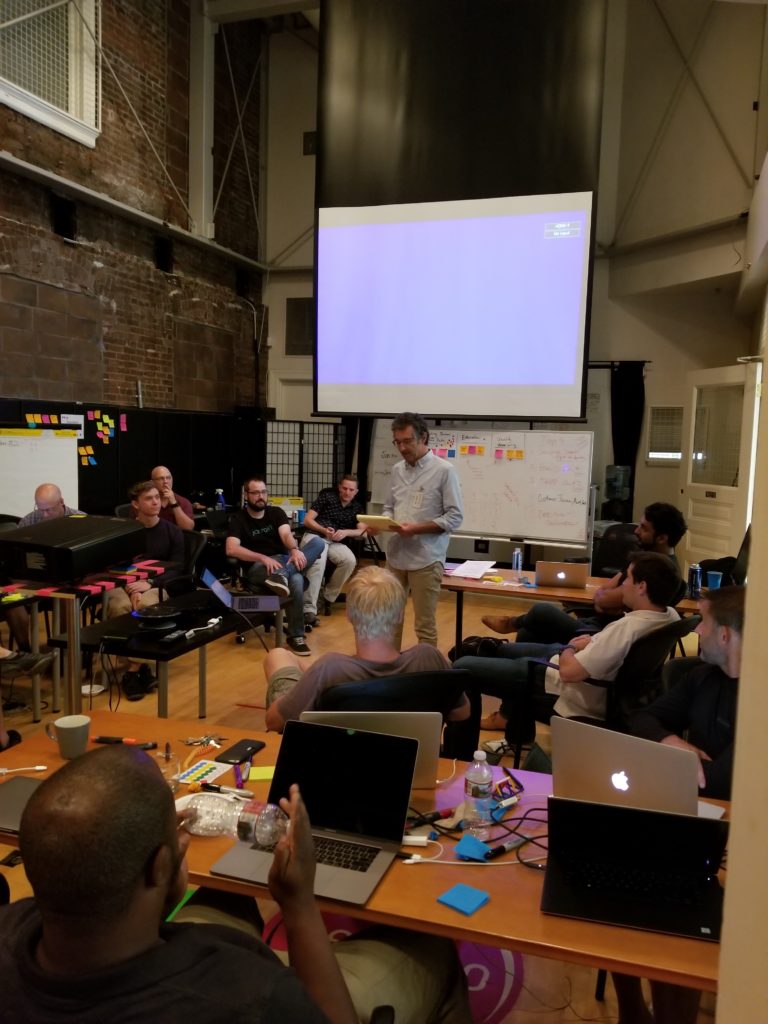Analytics in the Cloud
It had been a year since we kicked off our data initiatives with Roger Magoulas in 2016 and, yet, we hadn’t made the progress I needed by this 3Q17. It was our “Identity Analytics” theme quarter. So, I needed to turn up the heat for my team….which translated into making four strategic moves: 1) I sponsored a “data summit”, 2) I brought in some big data engineering talent to rearchitect our data infrastructure, 3) I hired a product manager of data products, and 4) I brought in one of my two favorites in big data to my QBR (my other favorite visited in 2Q16)!!! Lets talk a little about all of these.
Accelerating our Key Differentiation – Big Data & Analytics (Qtr 6 out of 11)
This is a picture of Roger Magulous (front speaker) and Dhruv Bansal (far upfront right), two of my most favorite people in the data space. Prior to our Q3 QBR, I sponsored a “Data Summit” with Roger and Dhruv leading the team. We worked on a number of “Data Themes” including:
- Real-Time data feeds for Security
- Fraud Analytics
- Customer Journey Analytics
- Reporting
- Data Science Core Competency
- Event Capturing and Big Data
- Descriptive Statistics across the Network
WOW! Was this a powerful day that included our engineering, devops, and product teams. I had a thesis for Janrain before I even became CEO – my thesis was that we could use data and analytics to create long-term competitive differentiation; that we could create an unfair advantage. It was a key part of my strategy for pivoting the company from a marketing-centric value proposition to a security-centric value proposition. But most importantly, I had a thesis that we could aggregate some of the most rich behavioral data feeds into a real-time risk engine for the most sophisticated adaptive authentication in the world that would fight the “bad guys” and provide incredible value to our clients. It was my main G2M lever. We also brought on Alan Elliot , our new VP of Sales (and later CRO), as part of our shift to security.
3Q17 Playbooks
Here are some of the playbooks we used in 3Q17. We were 6 quarters into my 5-year plan, and ultimately the 11 quarters before Akamai purchased us.
- Renewal Analysis: I had the finance team run through the data in detail. We sliced and diced again. I was ready to go through this analysis again, and again, and again…with the key purpose on how to invest in raising our GRR. For 2017 we had a simple goal of 90% GRR with a 15% add-on/expansion driving a DRR of 105%. In the end, we hit 117%.
- Top 3 Exercise: We always wanted to align the whole company behind knocking out three big issues that cut across all organizations. If your quarterly MBOs didn’t contribute to one or more of these, you were doing something wrong.
- Financial Cash Analysis: We had achieved one of the largest quarters in the company’s history in 2Q. However, our strength in sales bookings was offset by softness in renewals (we were at a DRR of 95% against a target of 99%). It always helps align the team around spend when you look at the big picture. This playbook always keeps one variable constant – cash.
- Renewal Stages / Checklist: Just as you have sales stages, you need renewal stages. From the time a new logo closes to the time that they renewal. What stages of probability do you use? Have you applied those stages to each of your clients to help predict churn. Each stage provides for a simple check-list to advance clients to the next stage.
- Top 10 Clients Support Burden – A Path for Training: In order to assess your support package effectiveness, you have to look at your leading clients (what will everyone look like when they all grow up?). Ticket volume, by severity level, YoY change in volume, developer-centric support, health. A data-driven exercise can really help you fine-tune your support model.
- PS Advisory Plan: If any playbook failed during my 3 years it was this one. We attempted to seed our professional services teams in the US and Europe with a “practice partner” supported by an “offering development” person in Product Management. Our thesis was that “tip of the spear” consulting could help us our clients see value, our sales team sell value, and ultimately for us to increase ROI.
- HR – Job Leveling & Career Pathing: I wanted a clear understanding of how everyone in the company would advance in their career. I called it “career pathing” and my head of culture/HR started this playbook with a “title leveling” exercise – making sure everyone was in the right job title / classification before creating the progression tracks.
- SDR Coverage Model: Do you have the right talent in the right regions working on both inbound and outbound with the right model?
- Sales Pipeline – Build & Prosecute: How to build and how to forecast accurately.
- Marketing Customer Advisory & Exec Sponsorship: Investing into a CAB (customer advisory board) turned out to be one of the hardest tasks for my marketing leadership to drive. We wanted to uncover latent challenges in our larger accounts.Higher ARR or brand value means that more management attention is needed. We customized our approach for larger accounts, meaning that more intimate knowledge of the account was required than CSM team leaders generally have the bandwidth to acquire for every account. So we assigned top accounts to executives across departments to give exposure to real customer issues in depth. The Top 50 clients across 10 execs as a start.
- Alliances Pipeline for Current & Prospect Deals: You have to drive a “partner-led” or “partner-first” or “all-in partner” program from the top. Leads sourced and influenced by partners doesn’t happen without an investment. And it’s not rocket science to know that partner-led deals have a higher close rate than not, and that on average you can drive down your sales cycles with well-run partner programs.
- BVD Analysis / Deepdive: I kept hammering on Product to develop a thoughtful roadmap process that was organized by categories of product value/assets. It was becoming very clear that we needed new thinking around the process at this point, which led to inviting in Todd Etchieson by March of 2018 (a process we started in 3Q17). BVD stands for “Business Value Deliverable” (it’s another phrase describing a “Market Requirement”).
- R&D Q3 Backlog for Data & Analytics (mini IRB + SCRUM plan): After running our BVDs, we ran a playbook to study our backlog, the roadmap, and how our needs for Data & Analytics activities were being accomplished this quarter. There was no letting up on the strategy.
- DevOps – Productizing our Identity Cloud Management: This is one of my more favorite exercises. Most SaaS companies lose sight of the value invested in cloud automation. We had 7 million lines of code (LOC) for our services and almost a million in cloud automation that covered: 1) provisioning, 2) serverless functions for alerts, WAF reputation, monitoring, and RI reallocation, 3) AWS instance management, 4) and our core identity services management…all for deployment. Then we had cloud automation for optimization covering: 1) scale-up/down, 2) cloudformation, and Terraform management. It was time to “productize” this with clear representation of the DevOps team on the Product Team. This is a playbook that many overlook.
- Privacy – GDPR Readiness Review (Services/Product, Resources, Pipe): My VP of Privacy was handed a playbook that forced the team to inventory our GDPR solutions, review our regulation-centric partners, assess our ability to deliver GDPR-compliance for our clients, discuss those in GDPR remediation already and in the pipeline for such, and continue to highlight areas where the product required more (BTW, our CISO/Infosec requirements were represented at the Product Management table as well).
- Critical Hires: This is a playbook that focuses on the hiring plan across all functions as a team. We did this during our QBR team event.
- Team Objectives Exercise – Top 5: This is the cornerstone playbook for senior team alignment every quarter. How to use it as a communication package for all the company.
- Senior Team 360: Performance vs. Potential as perceived by your peers. You’re not allowed to speak, only listen and say, “thank you”.
Our QBR Guests – Analytics on A New Big Data Platform
At our Q3 QBR, I invited in Dhruv Bansal. He and Destry Saul had helped us accelerate our data products work at Janrain over the previous two quarters. At the QBR, we summarized that work, which essentially was my way of kicking us in the pants around the data products work I had envisioned back in early 2016. I also decided to hire a Product Manager responsible solely for “Data Products” – Tim Gasper. Tim gets it, and at this point I was loosing time. Topics for our QBR included:
- Janrain’s Big Data Platform (needed to support real-time security)
- Key “Must-Have” Identity Analytics (how we presented ROI to our clients)
- How to Deliver Customer Insights V2 (a 100% migration to Looker)
- Telesign Fraud V1 moving to Fraud V2 (Adaptive/Risk-Based Auth)
- Customer Journey Analytics
- What do we need to win? No one in our space was doing this.
3Q17 Top 3 Issues
- Gross Churn – We needed another change in leadership, optimize the CSM role, refine the process, and focus on ROI with our customers. We moved from 75% to 90% including alot of forced/intentional churn.
- Pipeline – Moving to a Pod model helped. We also spent time on optimizing the SDR role, changing our SEO, and marketing differently to each prospect buyer persona.
- Engineering Velocity – This involved a significant shift to our outsourced model (75 out of 200 people were captured near and off-shore resources in the end). We also needed to kill projects that were distracting our talent. We moved from 41 story points to 448 over three years with only a 50% increase in budget. 10x for 1.5x is a pretty phenomenal ROI.
The Team
We took the senior team to Trillium Lake – a lake situated 7.5 miles south-southwest of Mount Hood in the U.S. state of Oregon. It is formed by a dam at the headwaters of Mud Creek, tributary to the Salmon River. We started with a 1-hour kayak event, followed by a hike around the perimeter of the lake.
Summary of quarters:
2Q16: Supercharging Your Leadership Team (Qtr 1 out of 11)
3Q16: Investing in Profitable Revenue (Qtr 2 out of 11)
4Q16: Making a Business “Repeatable” (Qtr 3 out of 11)
1Q17: The “aaS” Delivery Model (Qtr 4 out of 11)
2Q17: Compliance in the Cloud (Qtr 5 out of 11)
3Q17: Analytics in the Cloud (Qtr 6 out of 11)
4Q17: IoT affects All – Even Identity (Qtr 7 out of 11)
1Q18: Organizational Strategy (Qtr 8 out of 11)
2Q18: Extension Teams (Qtr 9 out of 11)






